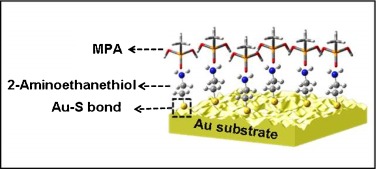SERS-based ultrasensitive detection of organophosphorus nerve agents via substrate’s surface modification
作者:Qian Zhao,Guangqiang Liu,Hongwen Zhang,Fei Zhou,Yue Li,Weiping Cai
期刊:Journal of Hazardous Materials
卷(期)页:Volume 324, Part B, 15 February 2017, Pages 194-202
全文链接:http://www.sciencedirect.com/science/article/pii/S0304389416309712?via%3Dihub

期刊:Journal of Hazardous Materials
卷(期)页:Volume 324, Part B, 15 February 2017, Pages 194-202
全文链接:http://www.sciencedirect.com/science/article/pii/S0304389416309712?via%3Dihub

Highly efficient detection of the organicphosphor nerve agents such as sarin and soman, based on surface enhanced Raman scattering (SERS) effect, has been in challenge due to their weak adsorption property on coin metals. In this paper, a new strategy is presented to achieve the SERS-based ultrasensitive detection of sarin-simulated agent methanephosphonic acid (MPA) via the surface modification of SERS-substrates. The Au-coated Si nanocone array is surface-modified with 2-aminoethanethiol and used as SERS-substrate for detection of MPA. It has been shown that the modified substrate could preferentially capture MPA molecules in the solution with coupling agent and induce amidation reaction. The reaction products are still bound or anchor on the substrate’s surface. The MPA molecules can thus be detected by Raman spectral measurement of the solution-soaked SERS-substrate. The minimum detection level is down to ~1 ppb. The Raman peak intensity versus the MPA concentration is subject to a linear double logarithmic relation from ~1 ppb to ~1000 ppm, which is attributed to Freundlich adsorption of MPA on the surface-modified SERS substrate. This study provides a new way for the highly efficient SERS-based detection of the organophosphorus nerve agents and some other target molecules weakly interacted with metal substrates.
上一条:Ultrathin tin oxide layer-wrapped gold nanoparticles induced by laser ablation in solutions and their enhanced performances
下一条:One-Step and Surfactant-Free Fabrication of Gold-Nanoparticle-Decorated Bismuth Oxychloride Nanosheets Based on Laser Ablation in Solution and Their Enhanced Visible-Light Plasmonic Photocatalysis
下一条:One-Step and Surfactant-Free Fabrication of Gold-Nanoparticle-Decorated Bismuth Oxychloride Nanosheets Based on Laser Ablation in Solution and Their Enhanced Visible-Light Plasmonic Photocatalysis
